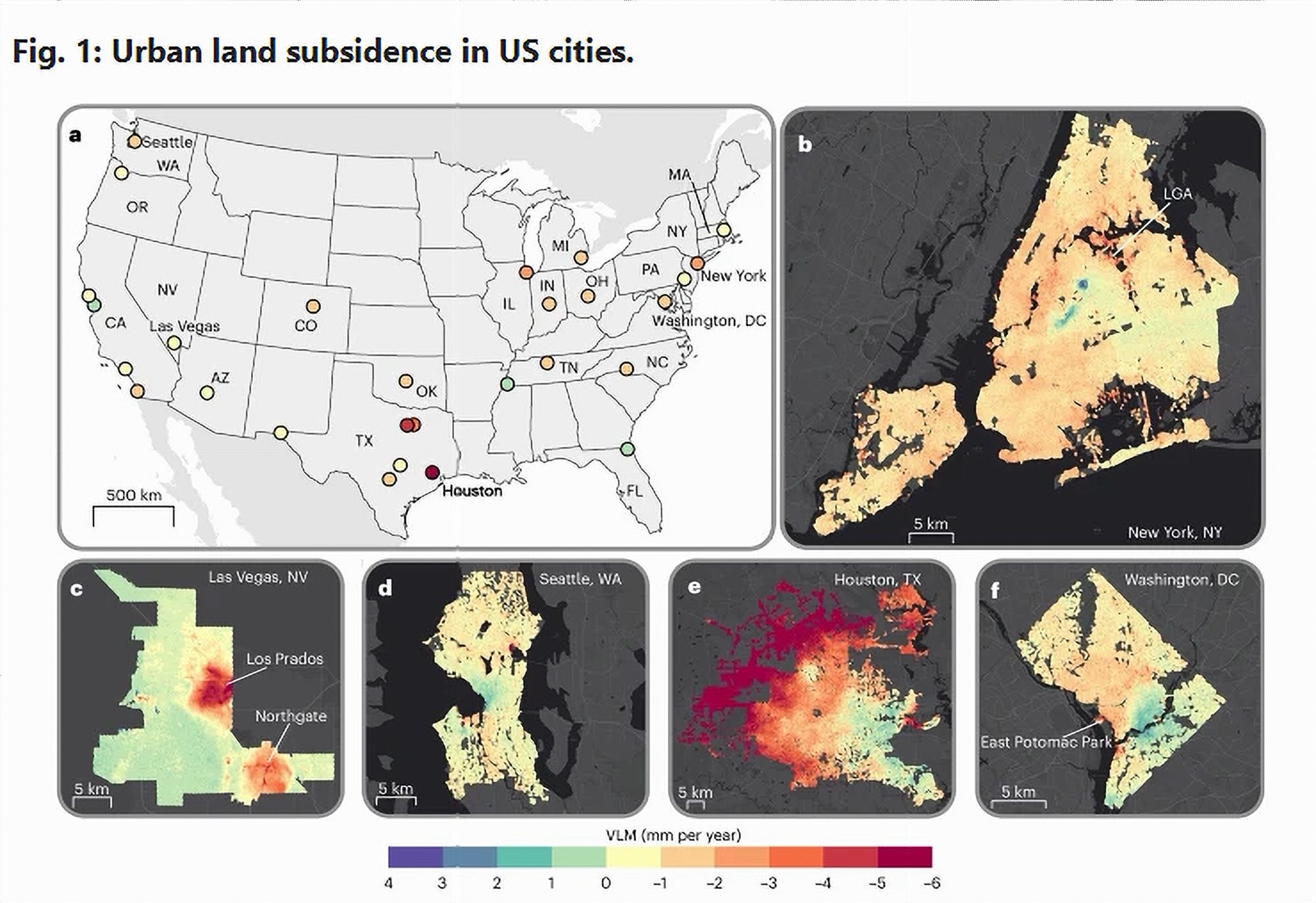- Over 33 million U.S. residents live on land that is actively sinking.
- In Phoenix, Las Vegas, Denver, and other Basin cities, groundwater pumping is a key driver.
- Houston and Dallas lead the nation in both rate and extent of urban subsidence.
- Infrastructure in Colorado River Basin cities is increasingly vulnerable to hidden damage.
Monday, May 12, 2025 — Land subsidence, which is the slow, steady sinking of Earth’s surface, has quietly become one of the most widespread and costly environmental threats facing U.S. cities. A new study published on Wednesday in Nature Cities has mapped the extent of this hazard in high resolution, revealing that at least 20% of the land in every one of the nation’s 28 most populous cities is subsiding. The root cause? Groundwater extraction, particularly in the drought-prone cities of the American West.
has mapped the extent of this hazard in high resolution, revealing that at least 20% of the land in every one of the nation’s 28 most populous cities is subsiding. The root cause? Groundwater extraction, particularly in the drought-prone cities of the American West.
Using six years of satellite data from 2015 to 2021, researchers calculated the vertical land motion (VLM) across urban landscapes and found that nearly 34 million Americans live on sinking ground. Cities like Houston, Dallas, and Fort Worth have the most dramatic shifts, but several key cities in the Colorado River Basin—including Phoenix, Las Vegas, and Denver—are not far behind.
Subsidence in the Colorado River Basin: Western Cities on the Decline.
Though much attention has been given to coastal cities threatened by rising seas, the inland metropolises of the Colorado River Basin are increasingly at risk due to rapid urban growth, ongoing drought, and continued groundwater pumping.
-
Phoenix, Arizona: The Phoenix metro area has recorded annual subsidence rates of up to 3.5 inches (9 cm), making it one of the fastest-sinking inland cities. According to the study, “notable subsidence greater than 5 mm per year” was observed in Phoenix, with 98% of the city experiencing some level of land sinking. The region’s dependency on groundwater during long droughts has led to significant aquifer depletion.
-
Las Vegas, Nevada: Subsidence in the Las Vegas Valley has also reached 3.5 inches per year in certain locations. The researchers noted two particularly vulnerable neighborhoods: Northgate and Los Prados. These areas are sinking at rates above 5 mm per year, a threshold known to heighten risks to roads, utilities, and buildings.
-
Denver, Colorado: Denver may be less commonly associated with groundwater depletion, but the study revealed that more than 65% of the city is sinking, with an average rate above 2 mm per year. This puts it among the top 10 U.S. cities for widespread land subsidence.
These findings matter. According to the study’s authors, even “modest rates of urban subsidence can profoundly impact the structural integrity of buildings, roads, bridges and dams.” Over time, those effects compound and can transform a minor concern into a crisis.
The Hidden Link Beneath the Surface.
Though not every instance of subsidence is driven by human activity, the study shows that “80% of the subsidence [in U.S. cities] is associated with groundwater withdrawals.” In confined aquifers—those under pressure from impermeable layers of rock—the study found a strong correlation between declining groundwater levels and land sinking. In places like Phoenix and Las Vegas, aquifers composed of fine-grained sediment are particularly prone to compaction when water is removed.
shows that “80% of the subsidence [in U.S. cities] is associated with groundwater withdrawals.” In confined aquifers—those under pressure from impermeable layers of rock—the study found a strong correlation between declining groundwater levels and land sinking. In places like Phoenix and Las Vegas, aquifers composed of fine-grained sediment are particularly prone to compaction when water is removed.
The mechanism is simple: as water is pumped out, pore pressure in the soil drops. That causes overlying materials to compress and the land to sink. And because these changes often happen gradually, the damage may remain invisible until cracks appear in buildings or roads buckle.
Building Risks.
In cities across the country, more than 29,000 buildings are now situated in zones categorized as having “high” or “very high” angular distortion hazard—areas where the land shifts unevenly beneath structures. This includes thousands of buildings in cities within the Colorado River Basin.
Houston leads with more than 3,100 buildings at very high risk, but Western cities like San Antonio (1,515 buildings), Austin (706), and Fort Worth (376) also rank near the top. The report notes that San Antonio, Austin, and Houston together “contribute more than 82% of the buildings at very high risk.”
While most Basin cities analyzed—Phoenix, Las Vegas, Denver—had smaller proportions of buildings in very high-risk zones, the authors caution that even small shifts in land elevation “can silently compromise infrastructure,” especially in aging urban environments.
Climate Change Risks.
The report adds a climate warning. As prolonged droughts reduce surface water supplies, cities turn more aggressively to groundwater. That, in turn, leads to further aquifer depletion and land subsidence. The study states: “The compounding effect of climate change and urban population and socioeconomic growth emerges as a critical concern, potentially accelerating subsidence rates.”
In the Colorado River Basin—where declining reservoir levels and a drying climate already threaten water security—subsidence adds a new layer of complexity. Efforts to manage water scarcity must now also consider geotechnical risks below ground.
The Need for Local Action.
Experts involved in the study stress the importance of locally tailored mitigation strategies. These include managed aquifer recharge, stricter land-use zoning, and retrofitting infrastructure in vulnerable zones. However, responses must be based on city-specific conditions. As the report notes, geological features like sediment type and aquifer structure can alter how land responds to pumping.
One clear takeaway from the data: the threat is not just theoretical. It is measurable, visible, and already impacting millions of Americans.
Source:
Ohenhen, L. O., Zhai, G., Shirzaei, M., et al. (2025). Land subsidence risk to infrastructure in US metropolises. Nature Cities. https://www.nature.com/articles/s44284-025-00240-y


Hi Sadie! It’s likely that the soil is simply compacting a bit each time you water that spot, which can leave a small depression after the water soaks in. If you’re worried and want to be on the safe side, you’ll want to rule out any hidden leak or subsurface erosion that could be washing soil away. If there are soggy patches beyond your tree’s drip line, signs of pooling water, or a dip that seems to be expanding quickly, it’s worth having a professional check your irrigation. Otherwise, modest settling from regular watering is pretty normal. Good luck!
Please ensure that this information gets to the legislators and city planners. These are the ones who are constantly pushing for growth and expansion. Brining in more people, jobs and revenue without considering the delicate balance of our ecological environment.
Thanks for bring this to our attention.
Larry Smith
Thank you, Larry!